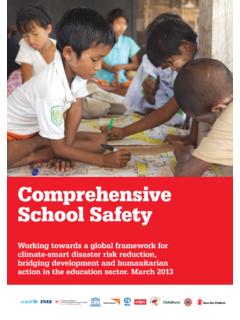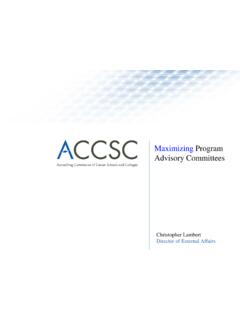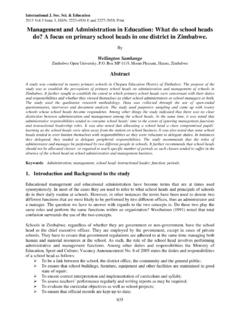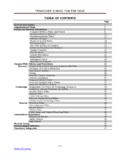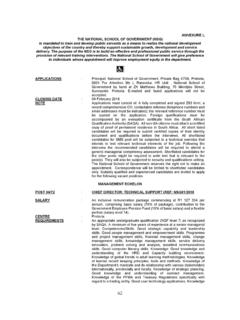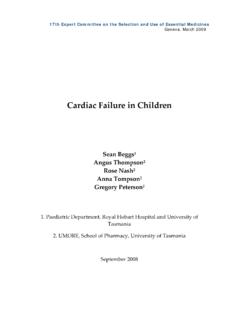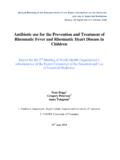Transcription of GUIDELINES ON SCHOOL HEALTH PROGRAMME …
1 1 GUIDELINES ON SCHOOL HEALTH PROGRAMME Introduction: SCHOOL HEALTH Program is envisaged as an important tool for the provision of preventive, promotive and curative HEALTH services to the population. The PROGRAMME which is functioning well in states like Tamil Nadu, Kerala, Gujarat and West Bengal have been analysed and documented, and various options worked out, so that they can serve as an information resource for the states. The states can, in the spirit of the flexibility of RCH and NRHM, modify the options as per their needs and the available options for service delivery. The SCHOOL HEALTH PROGRAMME would benefit 22 Crore students in 12, 88,750 schools all over India. Rationale for SCHOOL HEALTH PROGRAMME 2. The SCHOOL HEALTH PROGRAMME is the only public sector PROGRAMME specifically focused on SCHOOL age children.
2 Its focus is to address holistically the HEALTH and nutrition needs of children in a manner which fulfils the needs of today's lifestyle, hence activities like yoga and counselling facilities have been incorporated. It responds to the increased need of stress our children face, increases the efficacy of other investments in child development and ensures good current and future HEALTH . Successful SCHOOL HEALTH programmes ensure better educational outcomes, improved social equity and improved capabilities to handle the adult world. What is more, the huge added advantage in our resource constrained country is that all the services are provided for in a cost effective manner. 3. The PROGRAMME at the national level has been developed to provide guidance to States who are already implementing or plan to implement their own versions of PROGRAMME and to give guidance in proposing a coherent strategy for SCHOOL HEALTH PROGRAMME in the RCH PIP to all States.
3 Process adopted for developing the PROGRAMME 4 The decentralized framework of implementation under RCH can enable various states to devise and implement their own version of SCHOOL HEALTH PROGRAMME , as well assist those states already implementing this PROGRAMME to be able to compare it with the experiences of other states and improve their initiatives on the ground. A detailed study was undertaken through which the programmes being implemented in various States was documented .Through the analysis of the strengths and weaknesses of these programmes being implemented in various States a broad strategy for the SCHOOL HEALTH PROGRAMME was developed. 5. Components of SCHOOL HEALTH Program: HEALTH service provision: Screening, HEALTH care and referral: o Screening of general HEALTH , assessment of Anaemia/Nutritional status, visual acuity, hearing problems, dental check up, common skin conditions, heart defects, physical disabilities, learning disorders, behavior problems.
4 O Basic medicine kit to be provided to take care of common ailments prevalent among young SCHOOL going children. o Referral Cards for priority services at District / Sub-District hospitals. 2 Immunization: o As per national schedule o Fixed day activity o Coupled with education about the issue Micronutrient (Vitamin A & Iron Folic Acid) management: o Weekly supervised distribution of Iron-Folate tablets coupled with education about the issue o Vitamin-A as per national schedule. De-worming o As per national GUIDELINES o Biannually supervised schedule o Prior IEC with intimation to families to bring siblings to SCHOOL on the fixed day o Siblings of students also to be covered HEALTH Promoting Schools o Counseling services, Promotion of mental well-being. o Regular practice of Yoga, Physical education, HEALTH education o Peer leaders as HEALTH educators o Adolescent HEALTH education o Linkages with the out of SCHOOL children o HEALTH clubs, HEALTH cabinets, HEALTH jamborees o First Aid room/corners or clinics.
5 Capacity building of teachers and involved HEALTH personnel Monitoring & Evaluation Mid Day Meal Strategy for the PROGRAMME 6. Various options of implementation have been opted for implementation of the PROGRAMME in different States based on the assessment of various on-going SCHOOL HEALTH programmes . OPTION-1: Teachers screen students on a continuous basis and ANMs and a doctor visit the schools for treatment of minor ailments and referral services. OPTION-2: Existing ANM/MPW visits on a fixed day for screening, treatment of minor ailments and referral; with a follow up Doctor visit @ 1 SCHOOL per week OPTION-3: Two ANMs/MPWs/GNMs/PHNs/JPHNs are engaged per Block on contractual basis 7. Out of these options, one main strategy (Option-1) is recommended which brings uniformity/give guidance to the SCHOOL HEALTH programmes being implemented in various States and provides a framework for initiating the PROGRAMME in those states that have not yet started the PROGRAMME .
6 The 3 GUIDELINES along with the indicative costing will help the States to implement the PROGRAMME in a more structured and realistic manner. The detailed item wise costing has been done in the Ministry and will be shared with the states as and when the need is expressed. 8. It has been proposed that the PROGRAMME may be taken up in a phased manner covering 20% schools in the first year and 40% schools each in second and third year. The cost of implementation so phased can be met out of the RCH-II Flexible Pool. 9. Management Structure for effective management: Management structure as followed for the RCH PROGRAMME can be followed for implementation of the SCHOOL HEALTH PROGRAMME at national, State and District levels. The National Rural HEALTH Mission (NRHM) convergence mechanism can apply to this PROGRAMME as well.
7 The involvement of the Mission Steering Group, State HEALTH society and District HEALTH society can be ensured by placing the SCHOOL HEALTH PROGRAMME management committees under the overall supervision/guidance of these overarching structures. Committees for the oversight and co-ordination of the PROGRAMME : State level: Secretary (H&FW), Secretary (Education), Secretary (Rural Development), State Advisory Boards of education, Mission Director (NRHM), Director (H&FW), State SCHOOL HEALTH -coordinator District Level: District Magistrate, Chief Medical Officer, Director, District Board of Education, Director (District Institute of Education & Training), District SCHOOL HEALTH Coordinator. Block Level: Block MO, Block Resource Co-ordinator, MOs, selected principals and parents. representatives from Panchayat.
8 In addition, emphasis has been placed at making these management committees multi-departmental involving the functionaries of various related departments/organisations such as Education, Rural Development, WCD and NACO. Various SCHOOL HEALTH Promotion Committees are recommended at State, District, Block and SCHOOL levels. Representatives from parents, teachers, education officers, medical officer and other stakeholders can be the members of these committees. They can meet twice a year and can synergise the harmonious implementation of the PROGRAMME so that it suits the local needs. SCHOOL HEALTH Coordinator on contract basis at the State and District levels can be provided to support the PROGRAMME in the areas of coordination and monitoring and evaluation. At the State and district levels overall oversight can be provided by the NRHM Mission Director/District Magistrate/Local body and at the Village level by Village HEALTH and Sanitation committee.
9 1. The PROGRAMME formulated at the state level can then be implemented in a phased manner in the districts. States can evolve their criteria for phasing the 4 districts (20:40:40); however, all the NHSP shall be extended to all districts, under the National Rural HEALTH Mission (NRHM), by 2012. 2. The SHP co-ordinates with State HEALTH Resource Centres (SHRC), State Institutes of HEALTH and Family Welfare (SIHFW),State Institute of Educational Research and training (SIERT),District Institute of educational Research and training ( DIET) , Block Resource Centres and Cluster Resource Centres for accessing various PROGRAMME resources and for training purposes. Based on a cascading training strategy involving HEALTH and Education Departments ToTs will take place at State and District levels and teachers will be oriented on the PROGRAMME so that they internalize the core values and strategies of the PROGRAMME .
10 Apart from the teachers screening the children, area ANMs/MPWs will visit one SCHOOL every week on an average for detailed screening and treatment of minor ailment and required referral. In addition, a Medical Officer will also visit one SCHOOL per week for additional screening, treatment and referral. Format of networking with well defined job responsibilities Agencies at State/district/ village Job responsibilities 1. State HEALTH Resource Centres (SHRC) State institute of HEALTH and Family welfare (SIHFW)and State institute of educational Research and training (SIERT) Through participatory workshop, involving all the Stake holders formulate the SCHOOL HEALTH policy framework and draw an action plan for the State. 2. State HEALTH Resource Centres (SHRC) State institute of HEALTH and Family welfare (SIHFW)and State institute of educational Research and training (SIERT) Overall guidance, support, monitoring, Supervision of the program in the State3.

